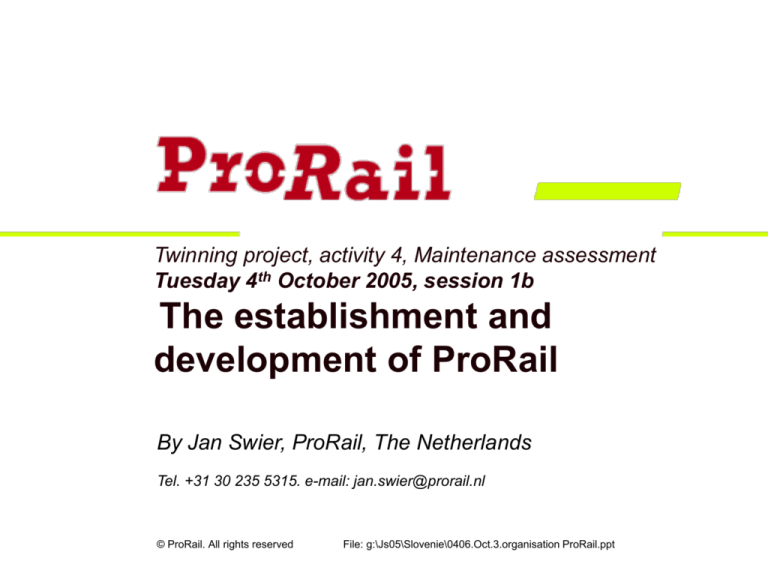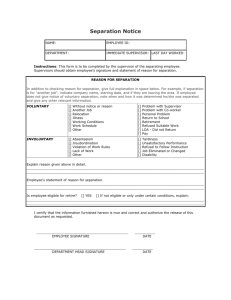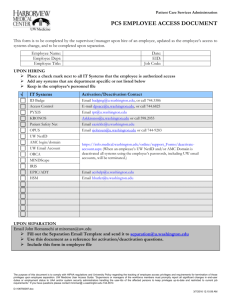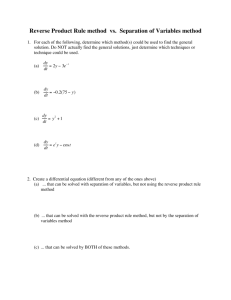
Twinning project, activity 4, Maintenance assessment
Tuesday 4th October 2005, session 1b
The establishment and
development of ProRail
By Jan Swier, ProRail, The Netherlands
Tel. +31 30 235 5315. e-mail: jan.swier@prorail.nl
© ProRail. All rights reserved
File: g:\Js05\Slovenie\0406.Oct.3.organisation ProRail.ppt
Presentation contents
*Separation of Train Operating Company
(TOC) and Rail Infrastructure
management: developments and lessons
learned
*Outsourcing of maintenance:
developments and lessons learned
2
Two important separations for
ProRail in a short period
1. Separation of TOC and Rail infrastructure
(1996); development initiated via EU
Directive
2. Separation of management and
implementation of maintenance, and .... its
outsourcing (1998); development based on
‘own’ initiative.
3
Separation of TOC and Infra in 1996
Train Operations
Rail Infrastructure
NV Nederlandse Spoorw egen
(Netherlands Railw ays)
Infrastructure mngt.
Rail Infra Trust
Capacity mngt.
NS Group NV
Corporate staff
Traffic Control mngt.
Business units
Passenger
Services
Freight
Services
Stations
Property
NS Facility Participations
Operations M ngt
TOC = Train Operating Company
4
Timetable for separation TOC
and Infrastructure
ProRail
independent
Crisis at NS: Strikes in 2001
and dismissal of BoM on 2 Jan
2002
Legal separation NS and Infrastructure
Separation of NS into business units
and accounting separation NS86,4 %
Infrastructure
New Railways Act
introduced
Concession model introduced
86%
84%
1990 1991 1992 1993 1994 1995 1996
Development
of punctuality
1997 1998 1999 2000 2001 2002 2003 2004 2005
79.8%
Minister’s announcement: “Stock exchange flotation NS after 1998”
Wijffels Committee:
*Separation of NS into independent business units
*Increased space for transport activities
*Government funding of Infrastructure via Infra Fund
Development of a
new Railways Act.
EU Directive 91/440/EEC:
*Accounting separation Operation - Infrastructure
*Variable infrastructure costs passed on to users
*Debt rescheduling, railway companies
*Greater independence in business operation
5
Possible intervention
(or governance) models
State-owned
company
Concession
system
Privatisation /
Regulation
Model selected for management
and operation of the railways in
the Netherlands
6
Separation of TOC from Infrastructure in the
Netherlands went far beyond the
requirements of the EU Directive
Separation between Operation and Infrastructure complied with EU
Directive:
*
accounting separation between TOC and Infrastructure.
However, the government and NS went far further:
* a legal separation between TOC and Infrastructure.
* a separation at ownership level: commercial and railway
infrastructure.
Advantage:
clear separation of responsibilities.
Disadvantage:
organisational and contractual separation, fully
eradicating the advantages of internal cooperation.
Negative influences:
*
The formal separation between Operation and Railinfrabeheer
took a great deal of time (1994 to 2001/2004).
*
Long period of uncertainty (1994-2002) about the position of NS:
option for a concession model, i.e. not for privatisation
7
Effect of the changes on the
organisations (1)
1.
1992-1995: expectation, anticipation, curiosity,. ..
2.
1994-1996: accounting separation resulted in considerable
financial clarity. All commercial infrastructure activities and assets
were then however also transferred to NS, so that the Government
and Railinfrabeheer had no income whatsoever from the
infrastructure
3.
1996-2000: uncertain position for Railinfrabeheer within NS and in
relation to Government. The position of Railinfrabeheer was
broadly determined by ‘others’. Consequence: weak starting
position for Railinfrabeheer (no knowledge, no experience, no
instruments, no information .... all necessary for the new task).
4.
1996-2001: excessive focus by management of NS on profits and
return on investments. To the detriment of rolling stock reliability
etc. Consequence: fall in punctuality.
5.
1996-2001: intended simplification of timetable led to much unrest
and uncertainty amongst drivers and conductors. Consequence:
fall in punctuality after 1999 and strikes in 2001.
8
Effects of the changes on the
organisations (2)
6.
1996-2000: considerable commercialisation of contacts between
NS and Railinfrabeheer. Relationships changed from informal
contacts to formal contracts. Consequence: sub-optimisation and
loss of synergy. By actively working on cooperation, things are
much better now.
7.
2001-2004: Introduction of new Railways Act and concession
model creates clear relationships and responsibilities.
Developments are tackled with more focus, energy and power.
8.
2004: Railinfrabeheer, Traffic Control and Capacity Management
merge to form a single organisation: ProRail. This corrected an
‘error’ from the past (excessive separation of organisations) thus
again encouraging cooperation and synergy.
9
Separation of TOC and Infrastructure: lessons learned
(according to: Maarten Veraart, AEF, Doctoral thesis on “privatisation”)
1.
Attractive plans are not the key to success: risk of ‘blueprint
thinking’ and underestimating process conditions is considerable.
2.
Changes desired from outside need internal support.
3.
Mobilisation of the shop floor for the objectives of change: appeal to
professional pride and develop a new form of professionalism.
4.
Professionalism is not only a protection factor for public interest
(‘good public transport’) but also serves as a motor for change.
5.
Trains and track cannot survive without one another; avoid suboptimisation by actively working at cooperation. Particularly when
handling disruptions and achieving taking out of service.
10
Background for outsourcing maintenance
(= separation of management and implementation of
maintenance)
Official:
–
Increased efficiency and innovation through competition.
–
Stronger infrastructure management; shift from technical to
commercial focus.
Unofficial:
– It was ‘fashionable’ to outsource in the nineteen nineties.
–Hiving off and selling maintenance generated funds for
NS.
11
Timetable separation of Management
from Implementation
(outsourcing maintenance)
Concession model introduced
Legal separation NS - Infrastructure
Separation of NS into Business Units
and accounting separation between
NS and Infrastructure
1990 1991 1992 1993 1994 1995 1996
New Railways Act
introduced
ProRail independent
Overhead value
analysis ProRail
1997 1998 1999 2000 2001 2002 2003 2004 2005
Start of introduction OPC+: Focus on output,
accountability for output and incentives, on quality via
maintenance management and alliance model
Introduction of OPC maintenance contracts:
Overhead value
analysis:
redundancy 600
staff
focus on activities and technical specifications
Privatisation of Maintenance into three companies
Separate placement of Maintenance in new organisation “InfraServices
Privatisation of Engineering office
Separation of Engineering office
12
Outsourcing of maintenance; shift in skills
Up to 1990
Head
(2)
1990-1994
Managing
Director
(1)
Staff
Staff
Heads of (10)
Technical
Technology Staff
Central
Regional
Regional
Manager
District head
Technology(5)
Section head
Technology
1995-1998
Managing
Directors
(2)
Staff
Technical
Staff
(5)
Regional manager
Technology (20)
Section head
Technology
Regional
Manager
Technical
Specialists
Technical
specialists
(3)
Regional head
Technology
(35)
Technical
specialists
© ProRail. All rights reserved
Team of
Directors
(4)
Staff
Technical
Staff
Regional
manager (7)
(80)
1999-Today
Regional
Manager
(4)
Manager Planning
Manager
Realisation
(4)
(4)
Contract
managers
(11+20)
Technical
specialists
13
Changes achieved in management
method
1994 Orientation
2003 Orientation
* Man hours
* Rules & Instructions
* Technology
* Budgets
* Implicit output
* Tasks
* Annual budget plan
* Costs
* Contracts (specifications)
* Business performance
* Results: costs and quality
* Explicit output
* Processes
* Multiyear production plan
© ProRail. All rights reserved
14
Outsourcing maintenance: Lessons learned (1)
(according to: Maarten Veraart, AEF, Doctoral thesis “privatisation”)
1.
Commitment by and between stakeholders is
essential.
Railway maintenance was left to its own fate in the years following
the separation of Operation from Infrastructure (1996). This applied
for both Railinfrabeheer and the maintenance contractors. The
government and NS failed to use their authority to safely direct the
process and to correct design errors.
2.
Crisis can help to compel stakeholder
commitment.
The NS crisis (2001, resulting in the dismissal of two NS Directors
on 2 January 2002) also had a disciplinary effect in the
maintenance market in respect of shareholders. It compelled
commitment.
3.
Internal support is necessary for change.
Sufficient strength for change is vital within the organisation. The
development of professionalism is the most important driving force.
This calls for programmes of change on and with the shop floor.
The likelihood of success of such changes depends heavily on the
strength of the informal organisation.
15
Outsourcing maintenance: Lessons learned (2)
(according to: Maarten Veraart, AEF, Doctoral thesis “privatisation”)
4.
Liberalisation of the maintenance market is
difficult.
Eight years following privatisation, the maintenance market is still a
closed market. Structure and behaviour restrict the possibilities but
do not prevent competition. The absence of a carefully considered
sector model in the start-up phase was one of the causes of the lack
of success, but certainly not the only cause.
5.
Privatisation of maintenance was forced.
Turning an internal service into a privatised maintenance business
calls for adaptation of the companies in various sub-areas: market
structure, personnel, organisation and financing. Privatisation meant
a leap forwards which the companies were not yet ready for.
6.
Because the four conditions for successful change
were not fulfilled, the results were disappointing.
The external and internal, formal and informal conditions were not
simultaneously met. The results after eight years are therefore
disappointing but .... matters did not get out of hand like in England.
This may be due to the continued existence of ‘railway loyalty’ on the
shop floor and amongst managers.
16
Phases of development towards (greater) independence and professionalism
(according to: Maarten Veraart, AEF, Doctoral thesis “privatisation”)
Contract relationship with client
Basis for pricing
Service comp.
Directives
Available
budget
Internal
independent
Management
contracts
Costs
External
independent
Legal contracts
(possibly) far-reaching (possibly) far-reaching
Privatisation
Legal
contracts
Integrated costs Market prices
Internal mandate
Limited possibilities
Possible
Basis for control
Budget control
Framework and (Planning and
control cycle
analysis
(Planning and
control cycle
Principles of
valuation
Cash system
Costs-benefits
system
Profit and loss
account
Profit and loss
account
Return standard
N/A
Cost coverage
(=zero)
N/A
Cost coverage plus
Sector standard
Public limited company
Public limited cokmpany
N/A
100%government Government<50%
Former
ProRail
Railtrack
2005
Legal form
N/A
Ownership structure N/A
SZ
Denmark,
Sweden, …..
17
Roles in the institutional triangle in the
Netherlands (2005)
*Legislator, Shareholder, Financier
*Supervisor, Concession granter
*Policy targets and Scope
*Guarantee Public Interest
Government
en
*Quality
*Functionality
*Capacity
*Available and safe
train routes
RIB
ProRail
VL
Train
operators
*Customers
*Trains
18
Business relationships in the Netherlands
within a concession model (2005)
•Management concession
•Management plan
•Financial model
•Track Access Charge
•Performance: KPIs
RIB
ProRail
VL
Process contracts
Project specifications
Government
Transport concession
(Passengers only )
Performance
contract
Passengers
Forwarders
Forwarder
Payment
Repayment scheme
Train
Network statement
Operators
Access agreement
Track Access Charge
Performance regime
Contractors
Engineers
19
Summary
1. The far-reaching separation between TOC (=NS) and Infrastructure is
viewed as positive. A possible risk is and remains sub-optimisation.
2. The transparent and commercial relationships between Government,
TOC and Infastructure are viewed as positive. It was therefore
essential that a clear choice be made for elaborating a governance
model.
3. Railinfrabeheer started with much ground to make up in terms of
position and development, because insufficient attention was paid to
this aspect for too long.
4. Outsourcing maintenance is not essential according to EU Directives
and does not automatically result in lower costs and higher quality. In
the Netherlands, the outsourcing of maintenance was a forced
occurrence, based on an incorrect situation assessment. This placed
ProRail at a considerable disadvantage in terms of administrative
powers and initiative. Fortunately, a great deal has now changed in a
positive sense.
5. The separation between TOC and Infrastructure and the outsourcing
of maintenance have brought about considerable development for
new management techniques, far better specification-measurementplanning, and (increasingly) greater understanding of the relationship
between costs, quality, time and parameters. These are the
preconditions for ensuring that a concession model functions
20
correctly.
Thank you for your attention
Any questions?
21









